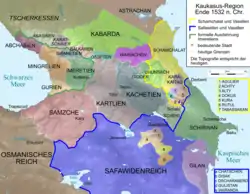Rutul Federation
The Rutul Federation or The Rutul Free Society is a Rutul state located in Southern Dagestan and was formed in the 7th century.[1][2][3][4][5][6][7][8][9]
Rutul Federation | |
|---|---|
 | |
| Capital | Rutul |
| Official languages | Rutul |
| Religion | Islam |
| Government | Monarchy |
| Establishment | 7th century |
Rutuli experienced strong cultural and linguistic pressure from Azerbaijanis and to a lesser extent from Lezghins.[10]
Before the annexation by the Russian Empire, the Rutuls made a federation of multiple rural communities which were known as the "Rutul Magal".[11][12][13][14] This Magal was ruled by a Bek, a permanent leader. These Beks address important issues and are required to convene to a popular assembly.
In the 17th century, the Rutul Federation included Tsakhur villages and captured some Lezgin villages. They did lose two Rutul villages to the Gazikumukh Khanate and two more to the Akhty Federation[14] (Akhty-para). This free society consisted of Rutul and Lezgi clans and was one of the largest free societies, along with Akhty-para, Alty-para and Dokuz-para free societies.[15]
History
In 1536, the Rutul Federation were allied with the Shamkhalate of Tarki to attack the Akhty Federation. The Akhty Federation attacked Rutul with the support of Derbent Khanate in 1541. Rutul attacked Akhty again in 1542, with the support of the Quba Khanate.[16] In 1574, Gazibek, a representative of the Shamkhalate of Tarki, became the leader of the federation.[17]
His name was mentioned several times: in 1588, the Turkish Sultan Murad III wrote a letter to Gazibek, congragulating him on gaining leadership over the federation. In 1598, Shah Abbas offered Gazibek assistance for the Tsakhur ruler Mahmedbek.
Beks
- Ilchi-Ahmad (early 15th century)
- Afrosimbeck
- Mahmudbek, son of Afrosimbeck
- Kazimbek, son of Mahmudbeck
- Muhammadbeck
- Gazibek (1574-1601)
- Ibragimkhan (1626-1635)
- Hasankhan (19th century)
References
- "Рутулы" (Дагестанская правда ed.). April 2008. Archived from the original on 2008-04-16.
16
- Петрович Гагарин, Сергей (1843). Всеобщій географическиій и статистическій словарь. Тип. А. Семена. p. 4.
- Гарун Халилович Ибрагимов (1978). Рутульский язык. Наука. p. 13.Исторически рутульские поселения образовывали территориальные вольные общества
- Омарович Хан-Магомедов, Селим (1998). Рутульская архитектура. Изд-во Ладья. pp. 54, 56, 339. ISBN 5706801053.
- Марк Осипович Косвен, Институт этнографии имени Н.Н. Миклухо-Маклая (1955). Народы Дагестана: сборник статей. Изд-во Академии наук СССР. p. 194.
- Институт истории, языка и литературы им. Г. Цадасы (1957). Очерки истории Дагестана. Дагестанское книжное изд-во. p. 205.
- Р.С.Ф.С.Р. Народный комиссариат просвещения, Институт этнографии имени Н.Н. Миклухо-Маклая (1953). Советская этнография. Изд-во Академии наук. p. 31.
- Institute of History, Language and Literature. G. Tsadasy. Essays on the history of Dagestan. - Dagestan Book Publishing House, 1957. - Vol. 1. - p. 205.
- R.S.F.S.R. People's Commissariat of Education, Institute of Ethnography named after N.N. Miklouho-Maclay. Soviet ethnography. - Publishing House of the Academy of Sciences, 1953. - Vol. Volume 1953. - p. 31.
- Wixman, Ronald (2017). Peoples of the USSR: An Ethnographic Handbook. Routledge. pp. 170/246. ISBN 1315475405.
- Статья Рутулы
- Агабек Рутульский: забытый наиб Шамиля
- Статья «Рутульцы»
- Народы Мира. Этнографические очерки. Народы Кавказа. Под ред. М.О.Косвена, Л.И.Лаврова, Г.А.Нерсесова, Х.О.Хашаева. Издательство Академии Наук СССР. 1960.
- Friedrich, Paul; Levinson, David; Diamond, Norma (1991). Encyclopedia of World Cultures: Russia and Eurasia, China. 6. G.K. Hall. pp. (241–243, 318)/527. ISBN 9780816118106.
- Магомедов Р. М. История Дагестана: Учебное пособие; 8 кл. — Махачкала: Изд-во НИИ педагогики, 2002 г. — 155 страница.
- Лавров Л. И. Рутульцы ⁄⁄ В сб. «Народы Дагестана». М., 1955.
